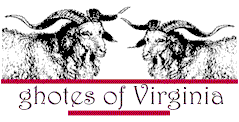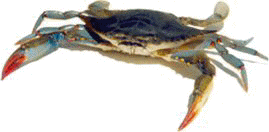“A
Community Gone: The Eastern Shore Natives”
The
“Eastern Shore Indians,” who first settled the area that is now Northampton
and Accomack Counties,
were a colorful, peaceful, and dynamic community. They consisted of about 2000 people in the
early 1600s and included at least fourteen tribes from the Mattawames to the
Gingaskins. They had such great Chiefs
as Debedeavon of the Nusswatocks and Ekeeks of the Auwanakus. Their community was a somewhat united but
spread out one of small villages. To begin,
we will describe their cultural origins.
The Eastern Shore
natives were descended not from natives across the bay but from natives of Pennsylvania,
Delaware and Maryland. They were of the Algonquin Family but were
familiar with the natives across the bay.
They did not trade with the mainland, but merely paid tribute to
Wahunsonacock, the Powhatan, or Emperor, on the mainland. This came in the form of beads, copper, and
skins they sent over in canoes. This
tribute is debatable, however, since Wahunsonacock lacked the naval power to
invade the Shore if the Eastern Shore natives did not
pay tribute. He may have ruled more
through fear of conquest. Yet, it can be
argued that the natives did have much contact with the Powhatan Confederacy
since they spoke the same language and since the Eastern Shore
natives received word of the Jamestown
settlement before John Smith’s arrival on the Shore.
One of the first English visitors
to the Shore was Sir Humphrey Gilbert who anchored on the southern tip of the
peninsula in 1603. He and his party were
promptly attacked by the local natives and Gilbert and one of his men became
the first casualties in the struggle between the natives and the settlers. This, however, does not reflect the overall
relations between the Eastern Shore natives and the
settlers. This attack was most probably
influenced by the Spanish and English explorers who had been in the area
previously. Then the immutable John
Smith arrived and explored the bayside and visited the Accomac and Accohannock
tribes in 1608. Smith estimated the two tribes’
warrior strength as 120 and their gathered population as 400, compared to the
Powhatan Confederacy which had 8000.
Thomas Savage, who was the first permanent English settler, had good
relations with the natives and learned their language. He knew the Emperor of the Eastern
Shore natives, Debedeavon, “The Laughing King,” who reigned over
the Nusswattocks tribe. Debedeavon took
a liking to Savage and bestowed upon him much land which reveals the generosity
of the Eastern Shore natives. This land goes by the name of Savages Neck
today. Debedeavon, also known as
Okiawampe, held court on Nandua Creek.
His brother, Kiptopeake, was in direct command of affairs of state. This way, Debedeavon could hunt, fish and
enjoy simple pleasures as he often preferred.
Many times Debedeavon placated the white settlers in order to keep the
peace. In one incident where his braves
had killed two white men, he sent two of his own men with peace offerings. Debedeavon was the last powerful native
Emperor on the Shore and died in 1657.
In his will, which is on record in Eastville, he designates his daughter
as his successor. The lineage of leaders
was matrilineal with descent from the mother rather than the father.
A typical Eastern Shore
native was brown or tawny in color, with dark eyes, straight black hair and a
beardless face. Clothing for a male
consisted of a breech clout of animal skin, often with the head or tail
attached. They wore deerskin moccasins
or went barefoot. Tied to the waist was
a satchel in which he carried stone tools, tobacco, and amulets. Hair was worn long on one side, the other
side plucked bald. Hair was also
ornamented with shell beads or bird feathers.
Ornaments such as hawks’ bills, eagle talons, and animal teeth were also
placed in the ears, and around the neck.
A woman’s attire was a fringed shirt or animal skin. In the summer women wore nothing above the
waist but in winter they wore a mantle of animal hide. Women’s hair would be long and tied in
braids. It would also be ornamented with
shells, ferns or flowers. The women
frequently had tattoos on their faces and bodies.
The Eastern Shore
natives were farmers, fishermen, and hunters.
The men fished, hunted, and fought in wars while the women farmed, made
mats, baskets, pots, and prepared food. It
should be noted that “wars” on the native scale usually contained no
casualties. Wars were fought as a game
to display strength and agility. As for
the ES natives, they were in general very peaceful, since they need not worry
about invasion from anywhere except the north.
This cultivated a very non-aggressive culture and made it easier for the
settlers to impede on the natives’ lands and rule over them.
Cultivated crops were vital to the
survival of the Eastern Shore natives. Corn was the most important product and was
raised along with beans, peas, and pumpkins.
There were also foods in the woods such as persimmons, berries, nuts and
roots. Tobacco was a valuable crop and
was widely used, mostly in religious rights as an offering. In addition there were wild berries that were
picked for sustenance and roots that were dug for medicines.
Beads of shell served as currency
and were called “roanoke” by the
natives. Purple shells were more
valuable than white shells and the natives used the beads to trade with white
settlers in lieu of money. Copper was also
highly prized, since bone, wood and clay were the only other raw materials.
Their homes were made of wood and
bark. Englishmen described native
“wigwams” as being “shaped like ovens with a hole at the top to let smoke
out.” These wigwams were also generally
filled with smoke from the fires. A
wigwam generally fit only one family and the “King” usually had the largest
wigwam.
To hunt animals, one would use the
bow and arrow. The arrowhead was made of
bone or stone and sometimes dipped in poison to insure a kill. This poison was found in a local root. After killing they would skin the animal
using a bone knife. They would then dry
the skin and eat the meat. Almost every
part of an animal was used by the natives from liniments to brains. To hunt fish, the natives used long arrows
tied on a line. They would then “shoot”
at the fish. They also used javelins
headed with bone hooks. These javelins
were noted in 1608 by John Smith’s expeditionary force who at first thought
they were implements of war.
As for funeral practices, it is
known that the natives buried their dead.
They used specialized practices for their kings, putting them in burial
houses with their riches. Many graves
lie undiscovered even today.
There was an old tradition of
making young men into “black boys.” This
occurred when the young man reached adulthood and he was placed in with the
bowmen. They were told that if they
“will be valiant and obedient to the Werowance, Wisos and Cockorooses, then
their god will love them, all men will esteem of them and they shall kill deer
and turkeys, catch fish and all things shall go well with them; but if
otherwise, then shall all go contrary which persuasion moves in them an
incredible obedience to their commands; if they bid them take fire in their
hands or mouths, they will do it, or any other desperate thing, although with
the apparent danger of their lives.”
The decline of the ES natives was a
relatively quick one. In 1622, a
massacre was planned by the mainland natives.
Debedeavon refused to take part and even warned the settlers of the
Shore. This received no award and even
helped doom the natives of the Shore.
Some were enslaved. Some were
killed outright. Some were bred out by miscegenation,
mostly into the black race. Some were
reduced to alcoholics due to the “firewater” that was traded to them by the
settlers. Lastly, some were killed due
to epidemics, such as the smallpox epidemic of 1677. This occurred after a quarantined white man
escaped from his bed in a blind stupor and went among the natives. Afterwards, the Eastern Shore
natives swore the settlers were out to extinguish them. Writing in 1705, Robert Beverly observed that
the natives “of Virginia are almost wasted…they live poorly…each town, by
articles of peace, 1677, pays three arrows for their land and twenty beaver
skins for protection every year.” Listed
as still in existence were the tribes of Metomkin, Gingoteague, Accahanock,
Pungoteague, Onancock, Chiconessex and Nandua.
None had more than 20 families. By
the time of the Civil War in 1861, the Eastern Shore
natives were a memory. Whites had forced
them to sell their land in Indiantown
Park near Eastville and most of the
natives moved north to Maryland. Indiantown
Park, today, would be the oldest
Indian Reservation in America
had it not been disbanded. As for the Eastern
Shore natives, many of their descendents still live on the Shore
today but there are no full blooded Eastern Shore
natives in existence. Overall, the ES
natives left no more than a memory and a few arrowheads. Their community, however, should remain a
revered, admired, and studied one.
Native Words and Meanings
Nusswattocks~stream
between two streams
Oanancock~(Auwannaku, Anancock)
foggy place
Accomack~(Achomack, Accawmacke)
other side place, place across the water
Accohanock~narrow
and winding stream
Matchapungo~place of
fine dust and flies
Chincoteague~(Gingoteague) land across the
waters
Chiconessex~(Chesconnessex) place of blue
birds
Kickoktank~(Kegotank) visiting place
Mattapony~bad
bread or no bread
Matomkin~(Mattemikin) to enter a house
Mattawaman~river of
shallows
Assawoman~rock
cave
Pungoteague~(Pungotekw) sand river or sand
fly river
Cuscarawaoc~place
of making white beads
Assateague~large
stream or inlet
Roanoke~place
of shells
Pocomoke~place
of shellfish and clams
Powhatan~place
of the falls
Chesapeake~people
of the great saline water
Werowance~Great
chief
Sources:
Turman, Nora Miller. The Eastern
Shore of Virginia
1603-1964. Bowie, Maryland.
Heritage Books,
Inc. 1964. ed.
Weslager,
C.A. The
Accomack and Accohannock Indians from Early Relations.
Eastville, Virginia.
Hickory House. 2001. ed.
Ghotes Website

 >>> Advertise Here <<<
>>> Advertise Here <<<